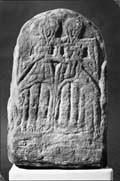Select a site alphabetically from the choices shown in the box below. Alternatively, browse sculptural examples using the Forward/Back buttons.
Chapters for this volume, along with copies of original in-text images, are available here.
Object type: Round-headed grave-marker
Measurements: H.40.6 cm (16 in); W. 28 cm (11 in); D. 17.8 cm (7 in)
Stone type: Medium-grained, rusty brown sandstone. [1]
Plate numbers in printed volume: Pl. 14.61-64
Corpus volume reference: Vol 1 p. 47
(There may be more views or larger images available for this item. Click on the thumbnail image to view.)
A (broad): There is a narrow frame round the top and part of the face enclosing two frontal figures whose shoulders and skirt hems are joined. They have one arm in common from shoulder to elbow. Their faces are wedge-shaped surrounded by hood-like haloes. Their shoulders are square and they have grotesquely long arms. The figure on the left is holding a book, the figure on the right a cross. They wear pleated tunics with looped hems, which are elongated between and to either side of their pairs of legs thus forming a sort of frame for their lower limbs.
B, D and E (narrow sides and top): Part of a continuous four-strand plain plait with median-incised strands is dimly visible.
C (broad): The two figures are identical in type with those on face A. The one on the right clearly holds a book, but it is impossible to be certain what the one on the left holds, although it looks more like a book than a cross. Their tunic hems join in a long pleat between their two bodies, and their lower limbs are enclosed in a roughly grooved frame which is inset from the edge of their tunics.
The way in which the figures are inset in the frame is like 3, but the composition of these figures and their looped hemlines are similar to Gainford 3. This is a wavering unconfident carving, but the use of these cut-out type figures on a grave-marker as well as crosses demonstrates how popular the type was at Aycliffe and Gainford.



